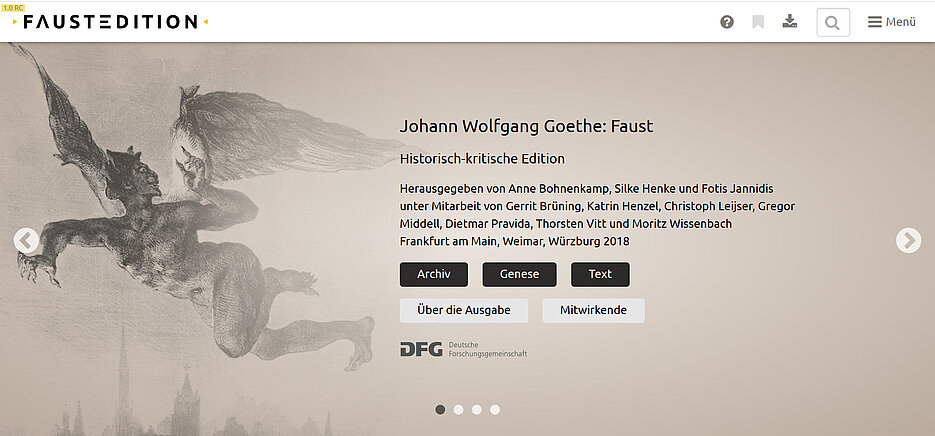Digital Edition of Goethe's "Faust"
10/24/2018The new contemporary edition of Goethe's "Faust" is the fruit of almost ten years of labour. The team of Fotis Jannidis, a computer philologist and Professor of Literature at the University of Würzburg, contributed significantly to this achievement.
Johann Wolfgang von Goethe (1749 – 1832) was occupied with his "Faust" for most of his life, writing, revising and revisiting it for over 60 years. A large body of manuscripts comprising over 2,000 pages has survived from this process. Additionally, there are prints published during Goethe's lifetime and more than 1,500 testimonies to the creation of the work.
Digital copies of all these documents and a newly constituted text are part of a new historical-critical Faust edition. It was presented at the Frankfurter Buchmesse in 2018.
What's special about this edition is that it combines a modern book-based edition with an innovative digital one, giving Faust research a comprehensive, scientifically grounded basis for the first time. Web-savvy users get online insights into Goethe's "workshop" where one of the most important works of German literature came to life.
The digital edition is freely available on the internet at faustedition.net
Work on the new edition started in 2009. It is jointly supported by the Freies Deutsches Hochstift / Frankfurter Goethe-Haus (Professor Anne Bohnenkamp-Renken) with the Goethe and Schiller Archive / Klassik Stiftung Weimar (Dr. Silke Henke) and the Chair of Computer Philology and History of Contemporary German Literature of Julius-Maximilians-Universität Würzburg, JMU (Professor Fotis Jannidis).
What the new Faust edition offers
For the first time, the digital Faust edition enables exploring Goethe's text from different perspectives. Based on their interests, users are offered different types of access, changing views and browsing options. The website has three main sections: an archive of manuscripts and prints, visualizations of the genesis of the work and a reading text.
The archive makes the entire work of Faust accessible in illustrations, transcriptions and witness descriptions. The offering gives all users unrestricted access to a virtual collection of Faust manuscripts and prints published during Goethe's lifetime for the first time. All manuscripts are available as high-resolution digital colour images, including many that have never been published before.
The genesis part includes various links to the archive. The variants presented in the textual transcription allow the user to retrace Goethe's writing process – from the first transcript to the finished labelling of a sheet. The genesis of the complete works across manuscripts is visualized in various diagrams for a synoptic representation.
The reading text allows users to navigate directly from the text of "Faust" to the edition. A reading text of both Faust parts is offered here first. Tables of content guide the user to the individual sections of the work, schemas and paralipomena. Goethe's preparatory records which the poet did not include in the final version of the work were published under the name of the latter after the poet's death.
Standards for digital editions upgraded
The new edition follows the guidelines for digital editions developed by the Text Encoding Initiative (TEI). The editorial team refined the standard together with TEI where the guidelines did not yet support the innovative encoding of a documentary transcription.
The XLM/TEI encoded text can be downloaded for each page and is equally available via Github which also provides the newly developed software as a download (https://github.com/faustedition).
The book-based Faust edition
None of the Faust versions included can be considered binding and authentic. For the new edition, a reading text was constituted which is based on an exact examination of all manuscripts and prints. It comes closer to Goethe's own wording and use of punctuation than any previous edition. This text is part of the new book publication (Wallstein Verlag) titled "Faust. Eine Tragödie. Konstituierter Text".
The book publication also comprises the volume "Faust. Der Tragödie zweiter Teil. Gesamthandschrift: Faksimile und Transkription". The complete manuscript, which comprises nearly 400 pages, is available as an elaborate facsimile of high quality. The front and reverse of the cover and all pages in folio format are represented, plus 26 glued pages and strips with handwritten corrections and additions – glued as in the original. The facsimile is accompanied by a transcription volume which renders the sometimes indecipherable original transcript character by character.
Project sponsors
The work on the new Faust edition was funded by the German Research Foundation (DFG) from 2009 to 2015. The going to print of the printed parts in the Wallstein Verlag was made possible by the support of the Alfried Krupp von Bohlen und Halbach Foundation.
Contact
Prof. Dr. Fotis Jannidis, Chair of Computer Philology and History of Contemporary German Literature, University of Würzburg , T +49 931 31-80078, fotis.jannidis@uni-wuerzburg.de







